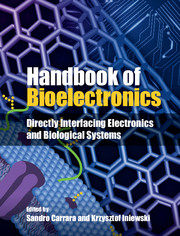Book contents
- Frontmatter
- Contents
- List of Contributors
- 1 What is bioelectronics?
- Part I Electronic components
- Part II Biosensors
- Part III Fuel cells
- 15 Biofuel cells
- 16 Advances and applications in biofuel cells
- 17 Switchable electrodes and biofuel cells logically controlled by chemical and biochemical signals
- Part IV Biomimetic systems
- Part V Bionics
- Part VI Brain interfaces
- Part VII Lab-on-a-chip
- Part VIII Future perspectives
- Index
- References
17 - Switchable electrodes and biofuel cells logically controlled by chemicaland biochemical signals
from Part III - Fuel cells
Published online by Cambridge University Press: 05 September 2015
- Frontmatter
- Contents
- List of Contributors
- 1 What is bioelectronics?
- Part I Electronic components
- Part II Biosensors
- Part III Fuel cells
- 15 Biofuel cells
- 16 Advances and applications in biofuel cells
- 17 Switchable electrodes and biofuel cells logically controlled by chemical and biochemical signals
- Part IV Biomimetic systems
- Part V Bionics
- Part VI Brain interfaces
- Part VII Lab-on-a-chip
- Part VIII Future perspectives
- Index
- References
Summary
Introduction
Rapid development of novel electrochemical systems was achieved in the1970–80s when a new concept of chemically modified electrodes wasintroduced [1,2]. Application of organic chemistry methods to thefunctionalization of electrode surfaces [3] and later pioneering of novelself-assembly methods [4–6] fostered the development of numerousmodified electrodes with properties unusual for bare conducting surfaces.While attempts were made to harness enhanced catalytic properties ofelectrodes and their selective responses to different redox species[1–6], the modified electrodes rapidly became important components ofvarious electroanalytical systems [7] and fuel cells [8]. Novelbioelectrochemical systems [9,10], particularly used in biosensors [11,12]and biofuel cells [13,14], have emerged upon introduction of modifiedelectrodes with bioelectrocatalytic properties. To continue this remarkablesuccess, electrodes functionalized with various signal-responsive materials(including molecular [15], supramolecular [16], and polymeric species [17])attached to electrode surfaces as monolayers or thin films were pioneered toallow switchable/tunable properties of the functional interfacescontrolled by external signals [18].
Over the past two decades, sustained advances in chemical modification of theelectrodes have given us a large variety of electrodes, switchable byvarious physical and/or chemical signals between electrochemicallyactive and inactive states [15–18]. However, very few of them wereused in biofuel cells [19,20]. Different mechanisms were involved in thetransition of the electrode interfaces between the active and inactivestates depending on the properties of the modified surfaces and the natureof the applied signals. The activity of the switchable electrodes wasusually controlled by physical signals (optical [21–23], electrical[24,25] or magnetic [26–29]) which failed to provide directcommunication between the electrodes and their biochemical environment inbiofuel cells. Switchable electrodes controlled by biochemical rather thanphysical signals are needed to design a biofuel cell adjustable to itsbiochemical environment according to the presence or absence of biochemicalsubstances. A new approach became possible when a polymer-modified electrodeswitchable between ON/OFF states by pH values [30] was coupled tobiochemical reactions generating pH changes in situ [31].This allowed transduction of biochemical input signals (e.g. glucoseconcentration) to the pH changes governing the electrochemical activity ofthe switchable electrode [32].
Information
- Type
- Chapter
- Information
- Handbook of BioelectronicsDirectly Interfacing Electronics and Biological Systems, pp. 215 - 238Publisher: Cambridge University PressPrint publication year: 2015
References
Accessibility standard: Unknown
Why this information is here
This section outlines the accessibility features of this content - including support for screen readers, full keyboard navigation and high-contrast display options. This may not be relevant for you.Accessibility Information
- 7
- Cited by
